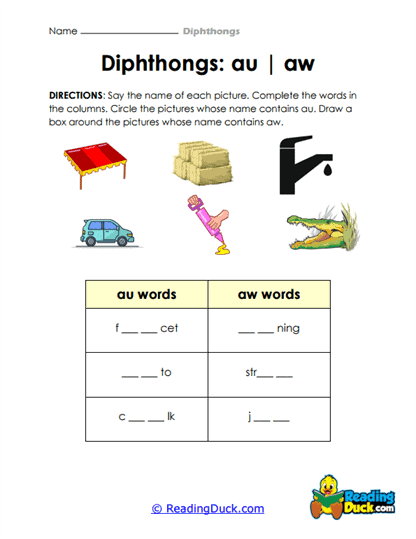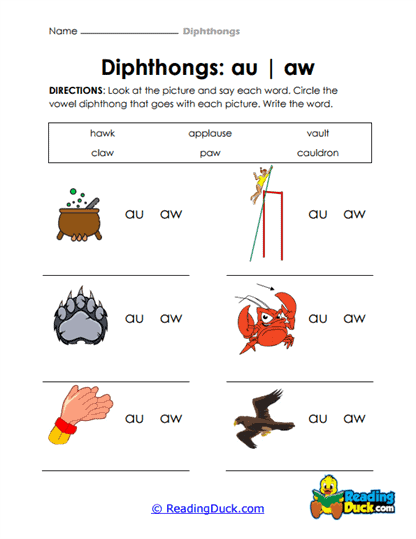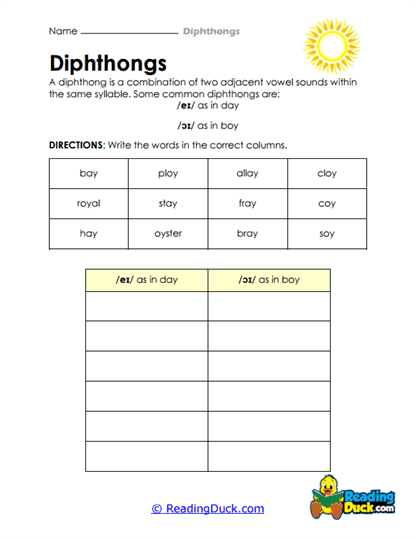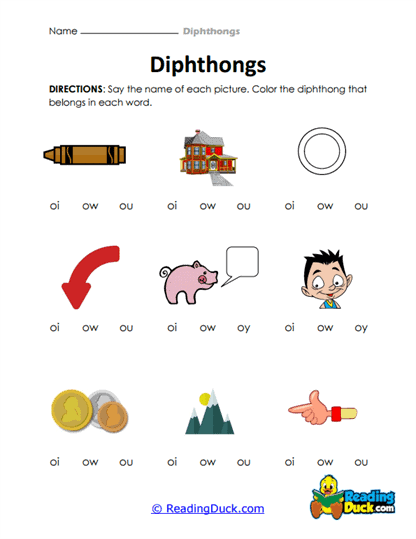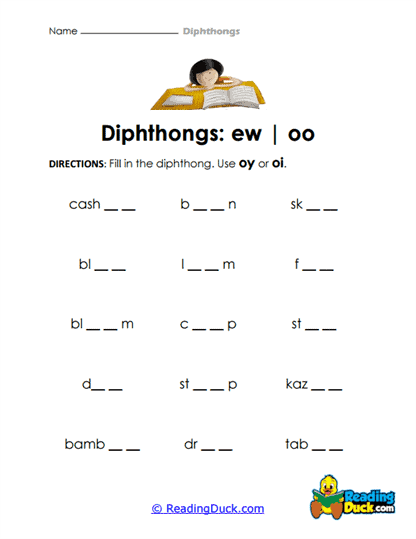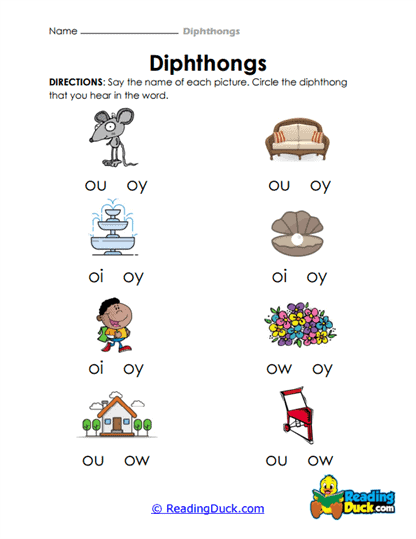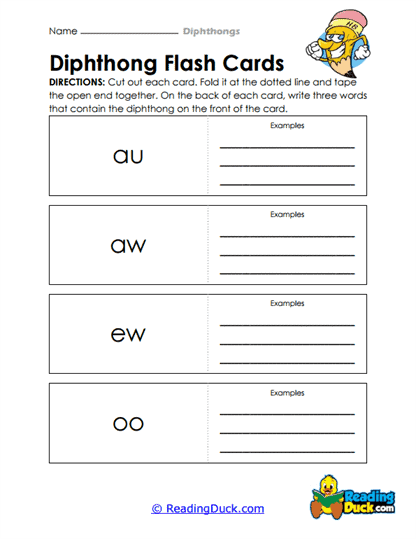Diphthongs Worksheets
About Our Diphthong Worksheets
Our collection of Diphthongs Worksheets is a vital resource within the 'Phonics' category of the 'Pre-Reading' section, meticulously designed to help young learners master the concept of diphthongs—complex vowel sounds essential to early reading development. These worksheets focus on teaching students how to recognize, pronounce, and use diphthongs in reading and writing, which are foundational skills for more advanced literacy.
The worksheets are available in PDF format, making them easy to view, download, and print, providing flexibility for both classroom and homeschool use. Each worksheet also comes with a downloadable answer key, ensuring that educators can efficiently guide students through the learning process and assess their progress accurately.
Understanding Diphthongs and Their Importance in Early Literacy Development
Diphthongs are an essential element of phonics instruction and play a crucial role in developing a child's reading and spelling abilities. As a professional licensed teacher specializing in pre-reading skills, it is important to provide a comprehensive understanding of what diphthongs are, why they are important, and how they contribute to a child's literacy journey.
What Are Diphthongs?
- Definition: A diphthong is a complex vowel sound that begins with one vowel sound and glides into another within the same syllable. Unlike simple vowel sounds, which remain consistent, diphthongs involve a shift in sound quality. Examples of diphthongs in English include the sounds /oi/ as in "boil" and /ou/ as in "house."
- Common Diphthongs: Some of the most common diphthongs in English are:
- /oi/ as in "coin," "boil," and "toy."
- /ou/ as in "out," "mouse," and "round."
- /ai/ as in "train," "rain," and "paint."
- /ea/ as in "bear," "tear," and "wear."
- /au/ as in "fault," "haul," and "autumn."
Importance of Diphthongs in Early Reading Development:
- Phonemic Awareness: Diphthongs are crucial for developing phonemic awareness, which is the ability to hear, identify, and manipulate the individual sounds in words. Understanding diphthongs helps children recognize that some vowel sounds are not static but change within the same syllable.
- Enhanced Decoding Skills: Recognizing and understanding diphthongs improves a child’s ability to decode words, which is essential for reading fluency. When children encounter words with diphthongs, they need to know how to blend the sounds smoothly to pronounce the word correctly.
- Improved Spelling and Writing: Mastery of diphthongs contributes to better spelling, as children learn the specific letter combinations that create these complex sounds. This knowledge is vital for accurate writing and spelling as they progress in their literacy skills.
- Reading Fluency and Comprehension: Understanding diphthongs also aids in reading fluency, allowing children to read more smoothly and with better comprehension. When children can quickly recognize and pronounce diphthongs, they are less likely to stumble over words, which enhances overall reading comprehension.
Examples of Diphthongs in Context:
- /oi/ in "coin": The word "coin" begins with the diphthong /oi/, where the sound starts with /o/ and glides into /i/. Recognizing this pattern helps students decode similar words like "boil" and "join."
- /ou/ in "house": In the word "house," the diphthong /ou/ shifts from the /o/ sound to the /u/ sound. Understanding this sound pattern is crucial for decoding words like "mouse" and "loud."
How These Worksheets Support the Learning and Practice of Diphthongs
Our Diphthongs Worksheets are thoughtfully designed to help young learners recognize, understand, and practice the sounds of diphthongs in a systematic and engaging way.
Structured Phonics Instruction:
- Gradual Introduction: The worksheets introduce diphthongs in a structured manner, starting with simple examples and gradually increasing in complexity. This progression ensures that students are not overwhelmed and can build their understanding step by step.
- Reinforcement of Phonemic Awareness: Through consistent practice, these worksheets reinforce the recognition of diphthongs, helping students identify these sounds in various words. This reinforcement is key to making these phonics patterns familiar and easy to apply.
- Encouraging Decoding Skills: By providing opportunities to decode words with diphthongs, the worksheets help children develop their decoding skills. This practice is essential for helping them read new words independently and with confidence.
Supporting Independent Learning:
- Self-Paced Practice: The worksheets are designed to be used independently, allowing students to work at their own pace. This flexibility is particularly beneficial in both classroom and homeschool settings, where students may have different levels of proficiency with diphthongs.
- Visual and Auditory Reinforcement: The worksheets include engaging visual aids, which help students associate the diphthongs with specific sounds. This visual reinforcement, along with auditory practice, caters to different learning styles, making the learning experience more comprehensive.
Strategies for Teaching Diphthongs Effectively
Teaching diphthongs requires a thoughtful approach to ensure that young learners grasp the concept and can apply it confidently in their reading and writing. Here are some strategies that educators can use to introduce and teach diphthongs effectively:
Introducing Diphthongs:
- Start with Simple Sounds: Begin by introducing the most common diphthongs, such as /oi/ and /ou/, using simple and familiar words like "boil" and "house." This provides a solid foundation before moving on to more complex diphthongs.
- Use Visual Aids: Incorporate visual aids such as charts, flashcards, or digital presentations that highlight the diphthong sounds. Visuals help students see the letter combinations and understand how they create specific sounds.
- Modeling and Guided Practice: Use a "think aloud" approach to model how to pronounce diphthongs. For example, break down the word "rain" into its individual sounds, emphasizing the glide from /a/ to /i/. Guided practice with the whole class or in small groups helps reinforce the concept.
Helping Students Master Diphthongs:
- Interactive Reading: Include books or passages that contain diphthongs in your reading sessions. Pause to highlight these words and discuss the sounds with students, reinforcing their understanding in a real-world context.
- Consistent Practice: Ensure that students have ample opportunities to practice diphthongs. Repetition is key to mastery, so integrate these sounds into daily phonics lessons, spelling activities, and reading exercises.
- Word Exploration: Encourage students to find and share examples of diphthongs in their reading materials. This exploration not only reinforces their understanding but also builds their confidence in applying phonics rules independently.
Practical Tips for Using Diphthongs Worksheets Effectively
To maximize the benefits of the Diphthongs Worksheets, educators and parents can implement the following practical tips, ensuring that young learners fully grasp the concept and apply it confidently.
Incorporating Worksheets into Daily Practice:
- Morning Work or Literacy Centers: Use the worksheets as part of morning work or in literacy centers. This routine practice helps reinforce diphthong patterns and prepares students for the day's reading and writing activities.
- Homework Assignments: Assign worksheets as homework to provide additional practice. Encourage parents to review the diphthong sounds with their children, reinforcing what was taught in class.
- Small Group Instruction: Use the worksheets during small group instruction to provide targeted phonics practice. This setting allows for personalized guidance and the opportunity to address any challenges students might face with diphthongs.
Supplementary Activities to Reinforce Learning:
- Word Sorting: Create a word-sorting activity where students categorize words based on their diphthong sounds. This activity helps them see the differences between various sounds and reinforces their understanding of diphthongs.
- Interactive Games: Incorporate phonics games that focus on diphthongs, such as bingo or matching games. These activities make learning fun and engaging while providing additional practice with the sounds.
- Creative Writing: Encourage students to write sentences or short stories using words with diphthongs. This activity not only reinforces the phonics patterns but also enhances their writing skills and creativity.
Empowering Young Learners with Diphthongs Worksheets
In conclusion, our Diphthongs Worksheets within the 'Phonics' category of the 'Pre-Reading' section are an essential resource for helping young learners develop strong phonics skills, particularly in recognizing and decoding complex vowel sounds. By focusing on diphthongs, these worksheets provide children with the tools they need to advance from simple word recognition to more complex reading and spelling.
These worksheets are not just about learning a phonics rule; they are about empowering children to become confident, capable readers. As they master diphthongs, students will find themselves better equipped to tackle a broader range of texts, which in turn fosters a love of reading and learning.
Educators and parents can use these worksheets to create a supportive learning environment that encourages both independent practice and guided instruction. Through consistent use, supplemented with engaging activities and real-world applications, students will develop a strong foundation in phonics that will serve them well as they continue their literacy journey.
Perfect for kindergarten through second-grade learners, these worksheets are an invaluable addition to any early literacy program. They ensure that young readers gain the skills and confidence they need to succeed, both in the classroom and beyond.
